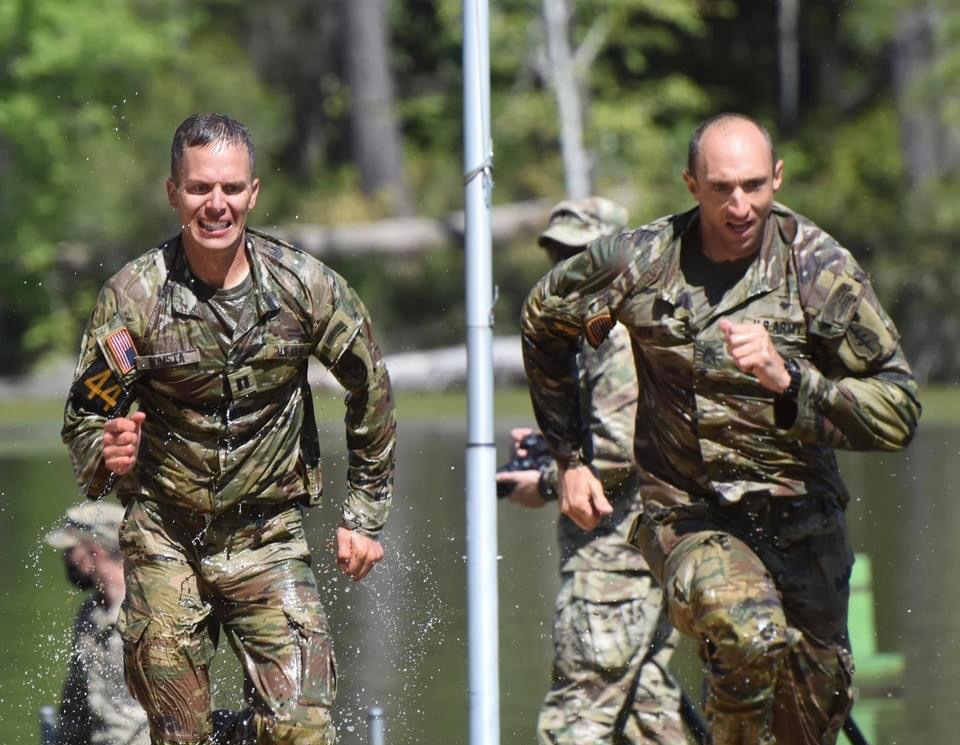Idaho Guardsman ranks top Guard team in Best Ranger Competition

Idaho Military Division Public Affairs/Crystal Farris
Idaho Army National Guardsman Capt. John Bomsta and his teammate, Sgt. 1st Class Nathan Smith from the West Virginia Army National Guard, were the top National Guard team and 10th out of 51 U.S. Army teams at the Best Ranger Competition April 18.
1st Lt. Christian Briggs, also in the Idaho Army National Guard, competed and placed 28th with his teammate, Spc. Jerry Marksbury from the Kentucky Army National Guard.
“Our Soldiers did an incredible job representing the National Guard and the Idaho Army National Guard at this year’s Best Ranger Competition,” said Brig. Gen. Farin Schwartz, assistant adjutant general – Army. “Their physical and mental perseverance is a testament to the quality of Soldier that makes up our great organization.”
It was the first time any Soldier from the organization had participated in the Best Ranger Competition since it started at Fort Benning, Georgia, in 1982. The competition determines the best two-Soldier team based on their performance through a series of physical and technical events day and night.
“This is truly a team event,” said Bomsta. “Similar to combat, you have to find strength in one another to keep going through your most vulnerable moments. My teammate was a brave man and, like me, would not quit. Finishing with someone of his caliber made the competition that much better.”
In addition to being Ranger qualified, Guardsmen must try out to place on a team and, if they advance, complete a three-month training course leading up to the competition. The course provides each Guardsman time to effectively train for the events and learn to work as a team, said Bomsta.
In September 2020, he made it through tryouts at Fort Benning and returned to attend the train-up course in January. Bomsta, Briggs and their teammates were four of 16 National Guardsmen who competed.
When he returned for training, Bomsta moved to an apartment in Columbus, Georgia, with his wife and four children. Having his family there at the end of each day provided much-needed support, Bomsta said.
For the next three months, his team trained with coaches 10 hours a day to prepare for the vigor of the competition. In the first few weeks alone, Bomsta said they walked almost 50 miles a week training on obstacle courses, in land navigation and during foot marches.
“We worked every day through the pain to prepare,” said Bomsta. “The competition had been a lifelong dream for us. We are both 34 years old and knew this could be our only shot. We formed a successful team by communicating our end goals and giving it our all to achieve them.”
The competition included a foot march, an obstacle course, a land navigation course, a buddy run, weapons qualification, combat water survival and infantry tactics. At the beginning of the competition, the particular events and order of events were unknown to participants.
“The first day opened with about an eight-mile run,” said Bomsta. “We ended that day with a foot march of more than 19 miles. The next day consisted of technical tasks, like shooting, repelling and mountaineering. On Day Three, we had the obstacle course, water assessment, more shooting and a final buddy run.”
Families and other spectators cheered on participants and observed some of the events. Bomsta said having his kids there was motivational and an opportunity to show them what hard work can do.
“To have my children see me do something hard and push through the pain was an awesome opportunity for a father to have,” said Bomsta. “Hearing them cheer me on picked me up and pushed me harder because there is plenty of need to be picked up in this competition.”
With little sleep over three days, Bomsta said he and his teammate struggled to stay sharp, especially during the technical tasks on the second day.
“We knew it was going to be a challenging competition,” said Bomsta. “We went in with a game plan to stay fresh for Day Two by not wearing ourselves out on the first day. We stuck with that plan for all of a couple hours until we got caught up in the excitement.”
By the end of the first day, Bomsta said his team did well on the weapons ranges and was fourth in the competition, which helped them push through the late-night foot march.
At that point, the teams in the bottom half were eliminated from the competition.
“Day Two was somewhat of a low point and cost us the opportunity to win the competition,” said Bomsta. “We were physically hurting, had no sleep and got complacent through the technical challenges. The land navigation course later that night turned into a second foot march and we ended up walking another 13 or so miles. In that moment, we just had to motivate each other to get through it.”
Some of the technical tasks performed the second day included treating an injured pilot while under fire before moving to an evacuation point, completing a hand grenade assault course, and assembling a mortar system on a bipod.
Although it was hard, the third day was better, Bomsta said.
“Just knowing we made that first cut gave us motivation to complete the competition,” said Bomsta. “We were so exhausted and the hard part was really maintaining focus. By the last event, which was a two-mile buddy run, I could almost taste the finish line. Once I crossed it, I had the biggest relief that it was over. I went straight to my family and collapsed in their arms.”
 Official Government Website
Official Government Website